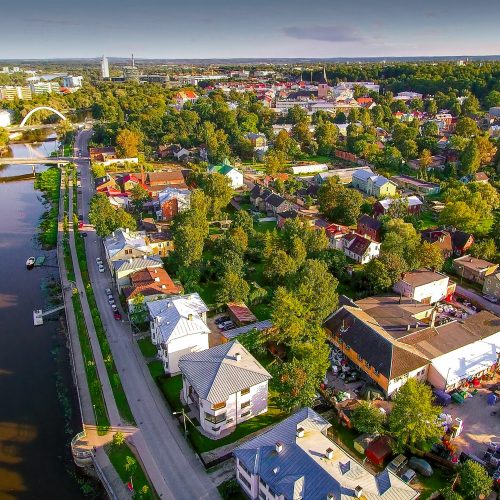Context and policy overview
In the early 1990s, the Federal State of Berlin faced a tight budget and a lack of financial resources. Energy-related costs were high (approximately €255 million per year) and there was potential for average savings of around 30 per cent.[1]
In 1994, the Berlin Senate’s Department for Health, Environment and Consumer Protection set a CO2 emissions reduction target: by 2010, it aimed to decrease CO2 emissions across all sectors by 25 per cent relative to the levels seen in 1990. Moreover, the Department introduced an updated Climate Protection Concept which set a CO2 emissions reduction target of 40 per cent by 2020, relative to the 1990 levels.
In this context, the Berlin Energy Saving Partnership approach was initiated in 1996 by the Berlin Energy Agency (BEA) and the Federal State of Berlin. The approach provides a framework for the project management of retrofits and tender preparation for renovation works, guaranteeing energy consumption reductions that are based on energy performance contracting (EPC).[2]
BEA is a public-private partnership between the government of the federal state of Berlin, the development bank KfW Bankengruppe and private stakeholders. BEA acts as the independent project manager, facilitating and managing the process from baseline to contract negotiation.[3]
Implementation
The necessary investments are made by a private energy service company (ESCO), the contractor, and refinanced by the energy costs saved. The contracting authority may combine a selection of its building stock into a so-called “building pool” which can be comprised of town halls, schools, swimming pools or administrative and service buildings. BEA plays the role of project aggregator, bringing together a number of buildings, from four to as many as 150, which are then classified as a pool via an EPC tender. This consolidation of buildings into packages encourages interest from multiple competent ESCOs and ensures good levels of competition and expertise.
Since 1996, BEA has successfully launched and supervised 26 energy saving partnerships covering more than 1,400 public buildings and more than 500 private properties in Berlin alone. Contractors have so far invested in excess of €50 million in energy retrofits. Energy saving measures have included the renewal and optimisation of building energy and ventilation control systems, the replacement of gas boilers and the installation of combined heat and power systems. The Berlin Energy Agency accompanies energy saving partnerships from the conception of a project to the realisation of the energy performance contract and is also responsible for the monitoring process.[4]
The energy contracting model is well established in Germany. The public sector remains an important client group for EPC, with significant ongoing potential for projects. The overall market size for energy contracting has been estimated at more than €4 billion, with energy performance contracting representing around 15 per cent of this market. The general suitability of public buildings is high due to stable patterns of use, openness to longer contract durations (more than 10 years) and extensive experience of EPC in the German market. At the same time, the percentage of EPC projects in the private sector is growing, with a strong focus on hospitals and healthcare, but also significant activity in the services sector and industry. EPC is less common in the residential sector due to a number of barriers such as the lack of a legislative framework, the complexity of tenure and uncertainty with regard to estimating energy reductions.[5]
Barriers and critical success factors
Germany has enjoyed a high level of political commitment to ESCO and energy efficiency projects. The country has one of the most mature ESCO markets in Europe. However, the general legal framework for energy performance contracting in residential buildings is currently not very supportive.[6]
Financing for projects is available, including risk mitigation instruments, which are backed by appropriate due diligence procedures and standardised processes. With 50 per cent funding from the Federal State of Berlin, BEA is able to make financially attractive offers to property owners. BEA also helps to raise awareness among customers, ESCOs, energy auditors and so on.
Moreover, the energy saving partnership is not limited to large building complexes. The grouping of smaller projects into pools means that transaction costs are reduced.[7]
Berlin has considered developing an Energy Saving Partnership Plus concept, aiming to extend partnerships to include building renovation and insulation measures such as heat insulation and window replacement. Furthermore, Berlin’s Energy Saving Partnership model has been transferred to other local authorities due to its low impact on the public balance sheet and its moderate staffing requirements.[8]
Results and lessons learned
The Energy Saving Partnership has proven to be a successful model for reducing energy consumption and improving efficiency in the city’s public buildings. Outcomes include the following:
- Over the first fifteen years of the programme, the average annual investment was €3.5 million, which supported energy efficiency measures in an average of nearly 100 buildings per year.
- The scheme delivered an average of 26 per cent savings in energy costs for building owners, with some individual schemes achieving savings as high as 40 per cent.[9]
The Berlin experience demonstrates the potential of energy performance contracting to delivery substantial energy savings. However, it also highlights the challenges faced by municipalities seeking to deliver energy efficiency investments without additional financial support from a higher-tier authority















